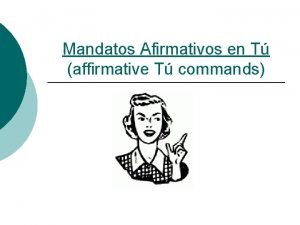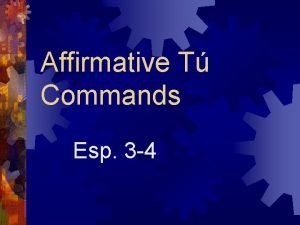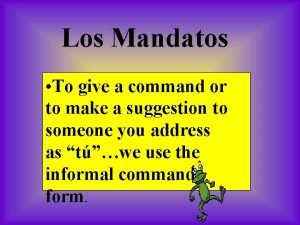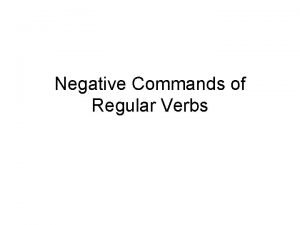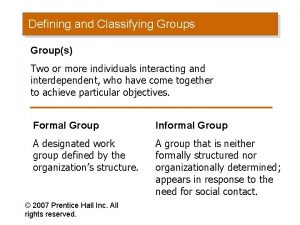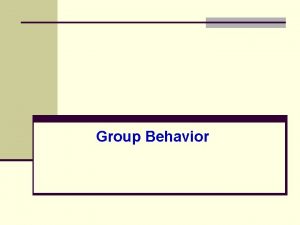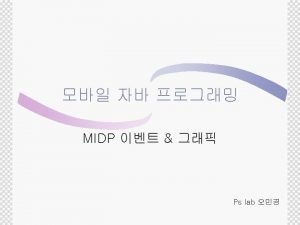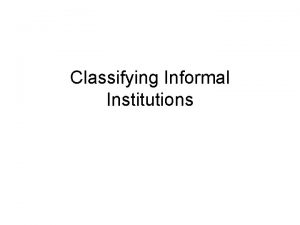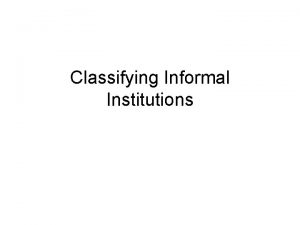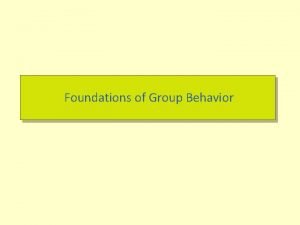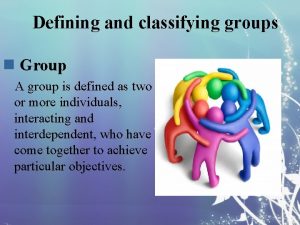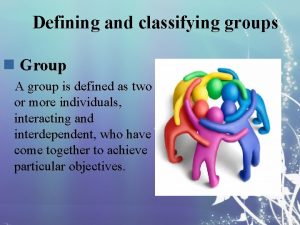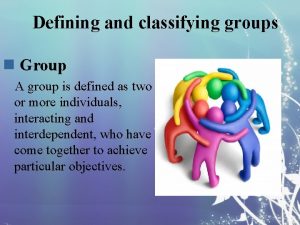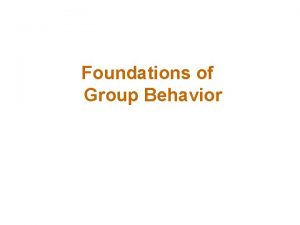Defining and Classifying Groups Command Groups Formal Task




















- Slides: 20

Defining and Classifying Groups Command Groups Formal Task Groups Interest Groups Informal Friendship Groups Prentice Hall, 2001 Chapter 8 1

1. FORMING Member Questions - What is expected of me? - What are our goals and why? - Who are these other people? - How do I fit in? - How much work will this involve? Interpersonal Issues Uncertainty, self-consciousness, Silence, Dependence Task Issues orient members, establish trust, establish clear purpose Leader Behaviors - Make introductions - Establish foundation of trust - Model expected behaviors - Clarify goals and expectations ©Prentice Hall, 2001 Chapter 8 2

2. STORMING Member Questions - How will disagreements be handled? - How will negative info. be communicated? - Can team members (leader) be changed? - How can we make decisions? - Do I want to stay on team? Interpersonal Issues Disagreements & competition among members, Cliques being formed, Task Issues Manage conflict, overcome group think, Examine key work processes Leader Behaviors - Be an effective mediator - Identify a common goal - Provide individual & team recognition - Foster win-win thinking ©Prentice Hall, 2001 Chapter 8 3

3. NORMING Member Questions - What are the expectations? - What role is best for me? - Will I be supported? - How much should I conform? - How much should I invest? Interpersonal Issues Cooperation, conformity to norms, Commitment to team vision Task Issues Maintain unity and cohesion, Clarify and differentiate roles Leader Behaviors - Facilitate role differentiation - Support team members - Provide feedback - Articulate vision - Generate commitment to vision ©Prentice Hall, 2001 Chapter 8 4

4. PERFORMING Member Questions - How can we continuously improve? - How can we be more creative? - How can we build on our competencies? - How can we maintain our energy & commitment to the team? Interpersonal Issues High mutual trust & commitment to team, Support of team members Task Issues Capitalize on competencies, improve speed Encourage creative problem-solving Leader Behaviors - Foster creativity & continuous improvement - Support team members in their roles - Provide ongonig feedback on team performance - Help team avoid reverting to earlier stages - Advance the quality culture of the team ©Prentice Hall, 2001 Chapter 8 5

Team Development 1. FORMING break the ice ; facilitate 2. STORMING conflict, disagreement ; resolve differences 3. NORMING order ; clarify roles and values 4. Performing cooperation, problem-solving ; task accomplishment 5. Adjourning group disbands when goals are met ©Prentice Hall, 2001 Chapter 8 6

Questions to be Asked? What are we trying to accomplish? Task vs. Growth & Development Who Should be on Team? Need for Functional Expertise - Engineering types - Operations / manufacturing - Marketing / sales - Finance / accounting When are people needed? ©Prentice Hall, 2001 Chapter 8 7

Punctuated-Equilibrium Model Performance (High) Phase 2 First Meeting Completion Transition Phase 1 (Low) Prentice Hall, 2001 Time A (A+B)/2 Chapter 8 B 8

Sociometry and Analyzing Group Interaction • Social networks • Cliques • Clusters • Stars • Isolates • Liaisons • Coalitions • Bridges • Emergent clusters • Prescribed clusters Prentice Hall, 2001 Chapter 8 9

Group Behavior Model Group Member Resources External Conditions Group Task Group Processes Performance and Satisfaction Group Structure Prentice Hall, 2001 Chapter 8 10

External Conditions Imposed on the Group • Overall strategy • Authority structures • Formal regulations Prentice Hall, 2001 • Employee selection • Evaluationrewards • Culture Chapter 8 11

The Resources of Group Members Knowledge, Skills, and Abilities Prentice Hall, 2001 Personality Characteristics Chapter 8 12

Identity Expectations Group Roles Conflict Prentice Hall, 2001 Perception Chapter 8 13

Performance Appearance Group Norms Resources Prentice Hall, 2001 Arrangement Chapter 8 14

Size of the Group • Small groups • Large groups • Social loafing • Individual effort Prentice Hall, 2001 Chapter 8 15

The Composition of the Group Diversity. Demography Cohorts Prentice Hall, 2001 Chapter 8 16

Cohesiveness-Productivity Relationship Cohesiveness Performance Norms High Low High Productivity Moderate Productivity Low Productivity Moderate to Low Productivity Prentice Hall, 2001 Chapter 8 17

Effects of Group Processes Process Gains Synergy Potential Group Effectiveness Process Losses Social Loafing Prentice Hall, 2001 Chapter 8 18

Group Decision Making Advantages Disadvantages v More Diversity of Views v Dominant Individuals v Increased information v Unclear Responsibility v Higher-quality decisions v Time and money costs v Improved Commitment v Conformity pressures Prentice Hall, 2001 Chapter 8 19

Accuracy Creativity Group Effectiveness and Efficiency Speed Prentice Hall, 2001 Acceptance Chapter 8 20
 Defining non defining clauses
Defining non defining clauses Relative clauses defining and non defining
Relative clauses defining and non defining Diferencia entre defining y non defining
Diferencia entre defining y non defining Defining relative clause meaning in telugu
Defining relative clause meaning in telugu Defining or non defining relative clauses
Defining or non defining relative clauses Adjectival clauses
Adjectival clauses Command group is type of
Command group is type of Command groups
Command groups Tiered task bias task
Tiered task bias task How are ethnic groups and religious groups related
How are ethnic groups and religious groups related Nosotros commands
Nosotros commands Que son mandatos
Que son mandatos Compartir affirmative tu command
Compartir affirmative tu command Planchar formal command
Planchar formal command Callarse tu command
Callarse tu command Affirmative formal command
Affirmative formal command Pasar informal command
Pasar informal command Quitarse formal command
Quitarse formal command Informal vs formal commands spanish
Informal vs formal commands spanish Relajarse affirmative tu command
Relajarse affirmative tu command Negative formal
Negative formal












